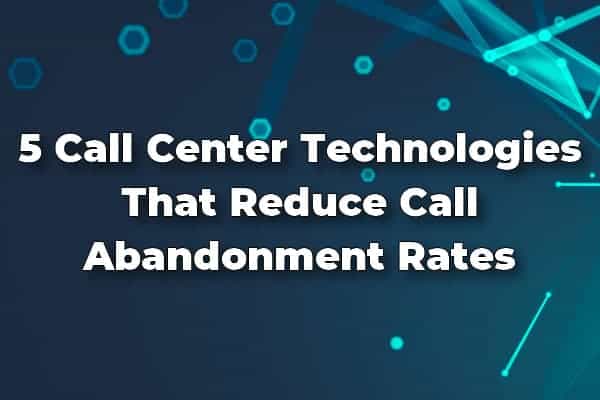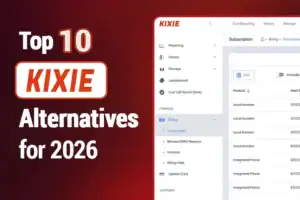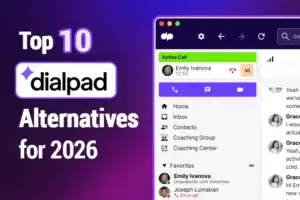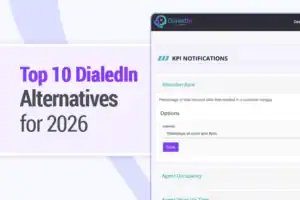Call abandonment is a phenomenon that call centers do everything they can to avoid. Customers frequently contact the service department when they are displeased with a brand’s product or service. They are obviously unhappy and are not in the mood to discuss.
Despite the fact that there are other ways to contact customer support, people prefer the phone. However, call center agents are not always accessible right away. As a result, clients are placed on hold, adding to their dissatisfaction.
Reducing call abandonment rate means connecting more with customers in a less impersonal way. To achieve this, you need to implement customer engagement strategies. At the same time, the most effective customer engagement strategies are available in the communication technology space.
Therefore, as you modernize your customer service, you should consider implementing these 5 call center technologies to keep your call centers moving.
What is the Call Abandonment Rate for Contact Centers?
The abandoned call rate is a Key Performance Indicator of customer contact center quality that can be applied to both inbound and outbound campaigns.
For inbound campaigns, it reflects the proportion of calls presented where the caller abandons the call due to excessive waiting time or a discouraging IVR. These abandonments can result in lost business opportunities in pre-sales or a poor customer experience in post-sales support. In the latter case, abandonment is most often followed by a repeat call.
The abandonment rate in an outbound campaign refers to the proportion of calls made by a predictive dialer that are picked up by receivers but not answered by an agent. When clients pick up the phone, they are often left without an agent or with an interrupted call. Consumers are irritated by the high proportion of abandoned calls in outbound calls. It is possible that the phone will ring numerous times in a single day without being answered.
The basic formula for calculating the call abandonment rate is as follows:
(Total calls – calls picked up) / (Total calls) x 100
How does call abandonment rate affect customer experience?
Customers must speak with a customer support agent as soon as possible. Otherwise, they will become upset and hang up the phone. They will then post their negative experience on the company’s social media or website.
As a result, the calls center and the company’s image suffer. It will also result in a significant decrease in the firm’s client engagement rate.
During peak call periods, for example, the Christmas season or Black Friday, call centers are being inundated with calls as a result of the surge in engagement requests. In a rush, agents may propose typical answers that are not necessarily appropriate for consumers. And customers who are still unsatisfied can call again, although they are not always given priority. As a result, they would rather hang up and post negative reviews on more visible digital media.
Abandoned calls in outbound campaigns can also be damaging for the reputation of a company. Abandoned calls from consumers have a negative impact on the customer experience. They often result in higher volumes of unsatisfied customers, the feeling that the call center is not very efficient, and lower brand loyalty and customer satisfaction scores.
The abandonment rate of outbound calls can be reduced using call management tools. With predictive dialer agents, it is possible to pre-categorize the abandoned calls and send only the requests that are likely to be answered. Such call management tools can also use the IR-dialling system to send messages with the opportunity for customers to opt for a call back with a representative or fix their problem themselves. Such a tool can prevent an unhappy customer from calling back again with the same complaint.
Does call abandonment rate affect customer service?
Although the decline in abandoned calls to the call center may not affect the overall customer experience, it can have an adverse effect on service. When calls go unanswered, companies must take the customer’s experience into account. It is one of the ways to improve the customer experience. If it turns out that a certain consumer has a bad experience, a company must make sure to improve the customer service.
Call failure rate and abandonment rate vary. In order to improve both, organizations need to analyze the specificities of their operations. It is possible to avoid a low call failure rate by identifying the customers who are more likely to hang up or stop answering their phones.
How to avoid abandoned calls? Here are 5 call center technologies you can use!
1.IVR – Interactive Voice Response
Businesses should invest in good Interactive Voice Response (IVR) to reduce wait times. Callers can choose from a menu and be routed to a trained agent using these technologies. Several time-consuming procedures are involved in this way of diverting calls from a menu. These stages are simplified using IVR, resulting in less waiting time.
Furthermore, during periods of high call volume, it is critical to notify callers of agent’s temporary unavailability. They will feel taken into account this manner.
Furthermore, the answering service might provide customers with the option of having a agent calling them back at a time that is convenient for them. When clients want to wait, it is preferable to inform them ahead of time how long the wait is expected to be. This will assist them in being patient.
In other words, with a good Interactive Voice Response system you can:
- Provides an effective solution to reduce abandoned calls without increasing staff.
- Improves customer service by giving customers choice, control and convenience.
- Allows businesses to reduce network costs by minimizing call waiting rates.
- Enhance the client experience, as it promotes consumer happiness while also delivering a personalized path depending on their profile.
2.Call Back
Customers despise waiting in line. The danger of the client hanging up increases as the wait time grows. Abandonment swiftly leads to customer discontent, recurring contacts, and reduced first-contact resolution rates.
If the waiting time is too lengthy and the desertion rate rises, some businesses may reinforce their teams while others would use call dissuasion. The first approach is prohibitively expensive, while the second is devastating in terms of client satisfaction. Is there an alternative for call centers?
Offering clients call-back is the greatest way to decrease customer service abandonment. By optimizing resources, automatic callback may smooth out calls during peak hours and balance supply and demand.
The callback option enables your call center to function at peak efficiency. As a result, employing it correctly provides a variety of substantial advantages in the area of offshore. These benefits range from shorter client wait times to considerably increased agent productivity.
Agents will never lose a lead with the aid of this technology, even if they are busy and cannot answer the phone in time. When a caller requests a callback, his information is saved and the relevant agent reaches him as soon as he is available.
3.Skill-Based Routing
It is usually wiser to use technology to improve client retention. Consumers today are well aware of their rights and will contact customer support if they are displeased. It is best to be able to access the department that matches to their purpose for calling.
Fortunately, skill-based call routing handle phone answering and link callers to agents with the relevant competence. This not only minimizes waiting time, but also keeps clients from being directed to the wrong platform.
Skill-based routing ensures that clients receive assistance from the most competent agent, who is armed with the most up-to-date tools and skills. Customer satisfaction increases when a contact center has a dedicated team with extensive knowledge. This ensures that concerns are routed to the most qualified agents for the subject at hand.
4.Media Blending
Another tool for absorbing peak demand and reducing queue overflow is to organize call center agents to handle contacts across several channels of communication with Media Blending.
Blended Media Handling refers to a set of tools and technology that allow contact centers to send and receive information over a variety of media channels, including but not limited to email, chat, websites, and the telephone.
It enables end-to-end unification across numerous communication channels, resulting in a single source of data, synchronized contact information across mediums, and clients who can enjoy a contextualized and seamless experience regardless of whatever channel they choose.
This omnichannel routing searches for agent availability independent of the channel on which they are currently working. If all of the appropriate phone lines are busy, the call may be routed to an agent who is generally in charge of SMS, webchat or social media interactions. This gives contact centers some breathing room in terms of capacity.
5.Virtual queues
Clients may hold a position in your queue and request to be called back using the Callback Queue function. You may even go one step further to boost client retention by implementing a “virtual queue.” It prevents your consumers from interrupting their activity to wait for you.
A virtual queue management system has various advantages, including:
- Decreased wait times and abandonment calls,
- Streamlined customer flow management,
- Greater staff productivity and service quality,
- Easier communication, and increased customer satisfaction.
- Delivers performance and consumer data for consistent excellent CX.
Conclusion
Call abandonment is a keystone metric that may be used to evaluate the effectiveness of a call center. The goal is to deliver the finest possible service to consumers. Observing the abandonment rate enables for the identification and correction of contact center dysfunctions.
It should be noted that call abandonment has a direct impact on customer satisfaction. Call waiting is one of the characteristics that define the quality of a customer’s experience and service. It is not unexpected that a high call abandonment rate and a poor satisfaction rate coexist. Working on this indication is equivalent to acting on customer happiness and loyalty.
At NobelBiz, we place the happiness of customers in the heart of everything we do. And we have more than 20 years of expertise providing comprehensive and customized solutions to call centers throughout the world.
Regardless of size, industry, or activity, our telecommunication services and contact center solution can satisfy the demands of any call center (Inbound, Outbound, or Mixed). Our customer care team is available 24 hours a day, 7 days a week. That is why we are renowned as the industry’s protectors of promises.
Our Cloud Communication Center Solution NobelBiz Omni+, can combine all communication channels (phone, social media, webchat, and SMS) into a single, unified platform. This will guarantee that your customers have a positive and memorable experience.
If performance and data are important to you. With the OMNI+ custom reporting engine, you can harness the power of data. Get trustworthy data from a variety of analysis and reporting tools that deliver real-time and historical data that you can tweak to produce complete performance reports. real-time data that may be customized to provide detailed performance reports.

Andrei is an experienced marketing professional specializing in propelling growth for both B2B and B2C companies. Proficient in streamlining marketing operations and enhancing lead and customer experiences through SEO and marketing techniques.






